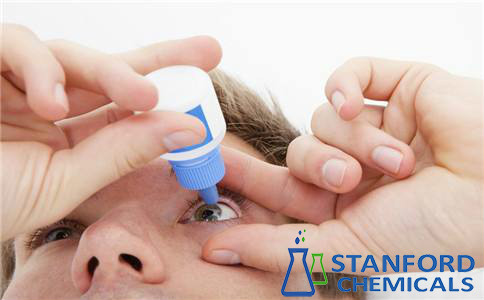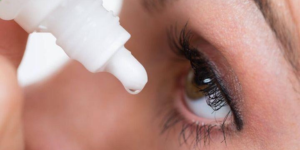From Surgery to Daily Care: The Versatile Role of Sodium Hyaluronate in Eye Health
Introduction to Sodium Hyaluronate
Hyaluronic acid (HA) is a high-molecular-weight polysaccharide with repeating disaccharide units of D-glucuronic acid and N-acetylglucosamine. Its salt form, sodium hyaluronate (SH), was initially isolated from the eye’s vitreous body. Sodium hyaluronate has a wide distribution in animal or human tissues, generally located in the extracellular matrix. It has a high concentration in the vitreous humor, aqueous humor, synovial fluid, skin, and umbilical cord.
Sodium hyaluronate is known for its excellent viscoelasticity, unique rheological properties, pseudoplasticity, non-toxicity, and superior biocompatibility.
Fig 1. Artificial tears with hyaluronic acid as the main ingredient
Basis for Sodium Hyaluronate in Ophthalmology Applications
It is highly moisturizing. Sodium hyaluronate can bind water several hundred times its weight, maintaining the ocular surface moisture balance. Its viscoelastic nature allows it to form a stable film on the eye surface, providing lubrication and protection while reducing friction.
As a natural constituent of human tissues, sodium hyaluronate possesses excellent biocompatibility with minimal risk of rejection or irritation. Furthermore, it provides an enhancement in corneal repair and regeneration, reduces inflammation, and soothes discomfort due to environmental stimuli or surgical procedures.
Given these properties, sodium hyaluronate is widely used in ophthalmic products such as artificial tears, surgical viscoelastic fillers, ophthalmic injectables, and corneal repair agents. Its applications range from routine eye care to advanced surgical procedures.
Fig 2. Viscoelasticity of hyaluronic acid
Applications of Sodium Hyaluronate in Eye Health
The uses of sodium hyaluronate in ophthalmology can be roughly divided into two categories. There is ophthalmic viscoelasticity, mainly used in all sorts of ophthalmic surgeries including glaucoma and cataract surgery; another one is eye drops, mainly used in treating dry eyes and corneal burns.
1. Ophthalmic Viscoelastic Agents
1.1 Role in Surgery
Sodium hyaluronate is used as a viscoelastic agent in many eye surgeries. It has a high molecular weight and excellent viscoelasticity, providing mechanical protection for the surgery to take place. Therefore, it maintains structure and prevents tissue collapse or damage caused by surgical instruments.
- Glaucoma Surgery
Sodium hyaluronate protects intraocular tissues, maintains the shape of the anterior chamber, and reduces friction and damage from surgical tools, thus enhancing safety.
- Cataract Surgery
It acts to safeguard the cornea endothelium and to serve as an aid to the implantation of an intraocular lens. It provides a clearer surgical field and minimizes mechanical trauma to the cornea during surgery.
- Trauma Repair Surgery
Sodium hyaluronate serves as a lubricant for the surgical procedure in ocular traumatized patients, inhibits the adhesion of tissues, and provides an optimal environment for healing after surgery.
- Corneal Laser Surgery
The protective film helps prevent excessive drying of tissues and reduces mechanical irritation from surgical instruments.
1.2 Recovery Post-Surgery
Sodium hyaluronate after surgery promotes the repair of tissues, reduces inflammation, and speeds up healing. It keeps the environment moistened to reduce any discomfort for the patients in recovery.
2. Eye Drops
Sodium hyaluronate is used in eye drops for moisturizing and lubrication, relieving dry eyes, protecting the ocular surface, and promoting corneal repair. It is suitable for sensitive people and postoperative care.
2.1 Treatment for Dry Eye
Dry Eye is a chronic condition caused by insufficient tear production or excessive evaporation, leading to symptoms such as dryness, fatigue, and a foreign body sensation. Sodium hyaluronate excels in treating dry eye due to its strong moisturizing properties.
- It forms a uniform protective film on the ocular surface, enhancing tear film stability and preventing tear evaporation.
- Its high water retention alleviates dryness and improves patient comfort.
- It enhances the repair ability of ocular surface cells, preventing more severe damage caused by chronic dryness.
2.2 Corneal Burn Repair
Sodium hyaluronate plays a vital role in treating corneal burns, where the cornea experiences water loss, cell damage, and inflammation. It helps in several ways:
- Moisturizing and Lubricating
- Promoting Cell Regeneration
- Reducing Inflammation
2.3 Daily Eye Care
Sodium hyaluronate-based eye drops are also widely used for daily eye care, especially by individuals who use electronic devices for extended periods or wear contact lenses. These drops effectively relieve discomfort caused by eye strain or insufficient tears, providing long-lasting hydration and lubrication.
Product Recommendations
Stanford Chemical Company (SCC) is one of the leading US-based wholesalers of hyaluronic acid, offering a range of pure hyaluronic acid powders in medical, food, cosmetic, and injectable grades. These cover high, medium, and low molecular weights and also support customization.
The main products in eye health:
| Item No. | Specification |
| HA-EM2.0-SC | M.W: 800K-1,300K Da,
I.V.: 1.44-2.12 m3/kg |
| HA-EM2.4-SC | M.W: 1,300K-1,800K Da;
I.V: 2.12-2.72 m3/kg |
| HA-EM3.0-SC | M.W:1,800K-2,500K Da;
I.V.: 2.72-3.53 m3/kg |
| HA-EMC-SC | Customized Molecular weight |
References:





This is a very comprehensive and informative article about
the role of sodium hyaluronate in eye health. As someone who suffers from dry eyes, I appreciate learning more about the benefits of sodium hyaluronate in eye drops.
It’s amazing how this natural substance can provide such effective
relief and protection for the eyes. I’m also impressed by
its use in ophthalmic surgeries, providing mechanical protection and preventing
tissue damage. It’s great to see that Stanford Chemicals offers a range of pure
hyaluronic acid powders for different applications.
This will definitely be a useful resource for anyone looking to improve their eye health.
Thank you for sharing this valuable information!